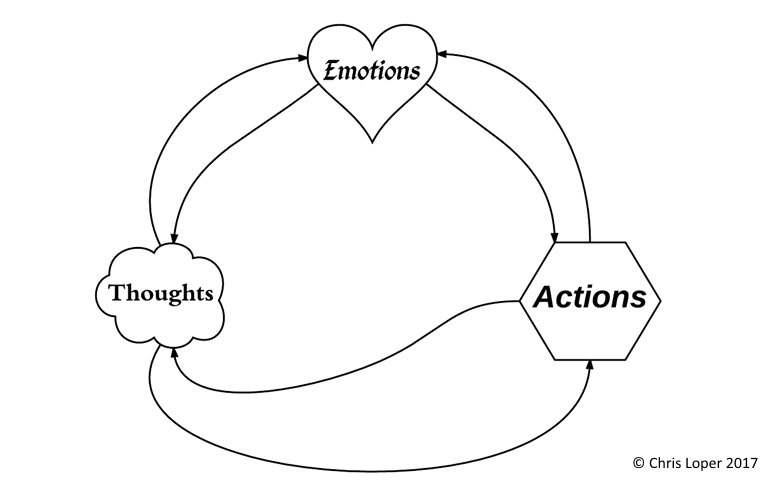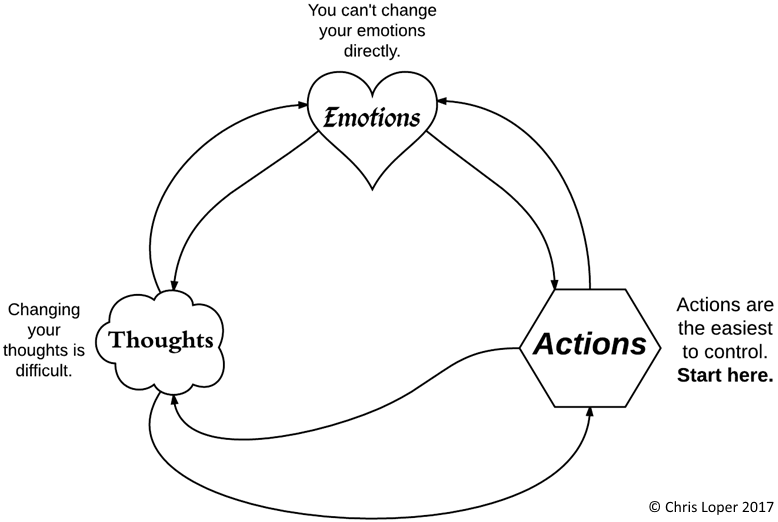
Our lives are controlled by three elements: emotions, thoughts, and actions. It’s easy to see how these elements matter. What we feel, what we think, and what we do are integral to who we are. What’s less obvious is how these elements interact.
Your emotions, thoughts, and actions are connected to one another in a bi-directional feedback loop. Each element influences the others.

Feeling a certain way causes you to think and act a certain way. Particular thoughts inspire particular actions and encourage particular emotions. And, most importantly, new actions can trigger new thoughts and new emotions.
For reasons that are not yet understood, the brain tries to align your emotions, thoughts, and actions; it prefers congruency between them. This means that a strong signal from any one of these three components can have a huge influence on the other two. This pull toward alignment can work in your favor … or not.
A Good Day
For whatever reason, you’ve woken up and found yourself in a good mood.
Because you feel good, you find it easier to get going with your day and do the things that are best for you. As a result, you feel even better. Because you’re more open to noticing good things today, you observe that the tree outside your window has started to develop a beautiful array of fall colors, and you marvel at the way its reds, oranges, yellows, and greens dance in the breeze and glow in the sun. You feel grateful. You think to yourself, How lucky am I to have such a view out my window?
As you go through your day, your good mood radiates to those around you because emotions are contagious. People enjoy your presence and you enjoy theirs. You initiate pleasant conversations. You smile at people, and they smile back. You think about how much you like other people. As a result, when the opportunity arises, you go out of your way to help someone. After helping that person, you think to yourself, I’m a good person. All of these things make you feel even better.
Your good mood leads to good actions and good thoughts, which reinforces your good mood, leading to even more good actions, thoughts, and feelings. When alignment works in your favor, you have positive momentum.
A Bad Day
The next day, for whatever reason, you wake up on the wrong side of the bed and find yourself in a bad mood.

Because you’re feeling grumpy, you’re not inspired to do the things that are best for you, and starting your day is a struggle. As a result, you feel worse about yourself. Because your perspective is biased to notice what’s wrong with the world today, you don’t notice the beautiful tree outside your window, and instead focus on the sound of passing traffic. You feel annoyed. You think to yourself, Why are these cars so loud? I’m so unlucky to live on a busy street.
As you go through your day, your bad mood is apparent to people around you, and they avoid you. When you do speak to people, you complain about the jerk who cut you off on the way to work, clients you dislike, or how tired you feel. They reciprocate and voice their own complaints. This makes you think about how the world sucks and life is unfair. This makes you feel defensive and self-absorbed. So when the opportunity arises to go out of your way to help someone, you think to yourself, I don’t have time for that. I’ve got my own problems to deal with. And now your brain gets to work justifying that thought by thinking of more reasons why your problems are too much to handle. This makes you feel even worse.
A bad mood can set off a downward spiral of negative actions, unhappy thoughts, and even worse emotions. When alignment works against you, a bad day just gets worse and worse.
Taking Control
If you don’t make a conscious effort to intervene in this feedback loop, it will control your life. But you are greater than the sum of your emotions, thoughts, and actions, and you can learn how to master them.
In both the positive and negative examples I gave, emotions were the driving force in the feedback loop, but that’s not a very good model for how to live your life. Letting your feelings drive the bus is a bad idea. The reason is simple:
You can’t directly control your emotions.
It would be nice if you could just make yourself feel happy whenever you feel sad or make yourself feel calm whenever you feel anxious or make yourself feel motivated whenever you feel lazy, but you can’t. No one can.
When you allow your feelings to dictate how you think and act, you’re giving the reigns to something outside of your control. This amounts to nothing less than abdicating your own free will. When emotions are driving the emotion-thought-action feedback loop, you’re not in charge of your own life.
We need to focus on adjusting the two dials we can control: thoughts and actions.
Thoughts
Unlike emotions, thoughts can be changed directly. This, however, is very difficult.
One reason it’s hard to change your thoughts is that many of our thoughts arise automatically. More troubling is the fact that most of these automatic thoughts are negative. Dr. Daniel Amen calls these automatic negative thoughts ANTs, and makes the case that keeping your ANTs at bay requires constant vigilance, a devotion to the fundamentals of brain health, and deliberate life design.1
In addition to ANTs, we all have ingrained patterns of thought. By thinking about things in the same way for years, we have wired our brains to think in certain ways habitually. These habits of thinking can be good, bad, or neutral. If we were lucky enough to be raised in an environment that encouraged helpful mindsets and productive ways of thinking, we might have good mental habits. More commonly, our ingrained patterns of thought are not particularly helpful and we have to work hard to change them.
However, I want to be clear that the answer to ANTs and unproductive habits of thinking is not “positive thinking.” The way to get your thoughts right is to get realistic. The challenge is not to see reality as unambiguously good, but to see reality for what it is, accurately assess your options, and then choose a pragmatic course of action.
This is the stuff of mindfulness, growth-mindset reframing, and cognitive therapy. This is a difficult and slow process, but don’t let that discourage you. It’s good work to do.
However, for more immediate results, change your behavior.
Actions
This is where you have the most direct control and the most leverage on the other two aspects of the feedback loop.
Yes, there are automatic behaviors, both instinctual and habitual, but most instincts can be tempered and all habits can be changed.
When we change our actions, our thoughts and feelings naturally start to align with our new behavior.

For example, if I don’t feel motivated to write, but I start writing anyway, I will discover after a few minutes of struggle that I’m starting to enjoy myself. I will remember that I love writing and think about how grateful I am for the opportunity to share my ideas with the world. This, in turn, makes continuing to write very easy. I develop positive momentum. Initially, I felt lazy, and my mind was generating excuses to justify not writing, but I took action anyway, and my emotions and my thoughts improved. (By the way, this is THE #1 way to overcome procrastination. Click here for a full breakdown of this strategy.)
“Our behavior is controllable in a way that our feelings are not. … The more control we develop over our actions, the more chance we have of producing a self we can be proud of.” –David K. Reynolds2
Our feelings are fickle and may fluctuate wildly from day to day or from moment to moment. And our thoughts are plagued by blind spots, biases, and ANTs. But we are always free to choose how to act, and taking positive action is the key to becoming better and mastering the feedback loop that controls your life.
P.S. The best way to take charge of your actions is by developing good habits, and the best way to do that is to work with a habit coach. Click here to learn more about habit coaching and to schedule a free consult.
1 Amen, Daniel. Change Your Brain, Change Your Life: The Breakthrough Program for Conquering Anxiety, Depression, Obsessiveness, Lack of Focus, Anger, and Memory Problems. Harmony, 2015.
2 Reynolds, David K. Constructive Living. University of Hawaii Press, 1984.
